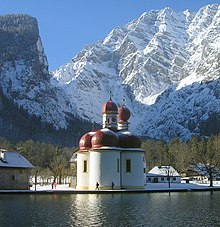Upper Bavaria: Difference between revisions
Samonymous (talk | contribs) →Population: Bayerisches Landesamt für Statistik |
|||
| Line 85: | Line 85: | ||
Featured former residence cities are the capital Munich, Ingolstadt and [[Neuburg an der Donau]] and the diocesan towns of [[Freising]] and [[Eichstätt]]. Interesting townscapes have especially also [[Landsberg am Lech]] and [[Wasserburg am Inn]]. |
Featured former residence cities are the capital Munich, Ingolstadt and [[Neuburg an der Donau]] and the diocesan towns of [[Freising]] and [[Eichstätt]]. Interesting townscapes have especially also [[Landsberg am Lech]] and [[Wasserburg am Inn]]. |
||
The highest mountain in Upper Bavaria, [[Zugspitze]], offers an incomparable panoramic view of the Alps. Nestled in forested mountain ranges, the lakes [[Tegernsee]], [[Schliersee]], and [[Spitzingsee]], are idyllically situated. The larger lakes like [[Starnberger See]], [[Ammersee]] (south-west of Munich), and [[Chiemsee]] further to the east, offer regular Passenger services on steamers. Sacred art treasures can be found in the monasteries [[Andechs]] and [[Ettal]] and in the [[Wieskirche]]. Among popular excursions in Upper Bavaria are the [[Koenigssee]] with the Sanctuary of St Bartholomew's and the mountain [[Watzmann]], the royal castles of [[Ludwig II of Bavaria|Ludwig II]], [[Linderhof]] and [[Herrenchiemsee]] in [[Chiemsee]], the [[Burghausen Castle]] and the castle [[Aschau im Chiemgau|Hohenaschau]]. The most important place of pilgrimage is [[Altoetting]]. |
The highest mountain in Upper Bavaria, [[Zugspitze]], offers an incomparable panoramic view of the Alps. Nestled in forested mountain ranges, the lakes [[Tegernsee]], [[Schliersee]], and [[Spitzingsee]], are idyllically situated. The larger lakes like [[Starnberger See]], [[Ammersee]] (south-west of Munich), and [[Chiemsee]] further to the east, offer regular Passenger services on steamers. Sacred art treasures can be found in the monasteries [[Andechs]], [[Benediktbeuern Abbey|Benediktbeuern]] and [[Ettal]] and in the [[Wieskirche]]. Among popular excursions in Upper Bavaria are the [[Koenigssee]] with the Sanctuary of St Bartholomew's and the mountain [[Watzmann]], the royal castles of [[Ludwig II of Bavaria|Ludwig II]], [[Linderhof]] and [[Herrenchiemsee]] in [[Chiemsee]], the [[Burghausen Castle]] and the castle [[Aschau im Chiemgau|Hohenaschau]]. The most important place of pilgrimage is [[Altoetting]]. |
||
==References== |
==References== |
||
Revision as of 15:59, 15 May 2014
Template:Infobox German Regierungsbezirk

Upper Bavaria (German: Oberbayern) is one of the seven administrative regions of Bavaria, Germany.
Geography
Upper Bavaria is located in the southern portion of Bavaria, and is centered around the city of Munich. It is subdivided into four regions (Planungsverband): Ingolstadt, Munich, Bayerisches Oberland (Bavarian Highland), and Südostoberbayern (South East Upper Bavaria). It is named 'Upper Bavaria' because the land is higher above sea level than the rest of Bavaria, not because it is farther north.
|
Landkreise |
Kreisfreie Städte
|
Population
Historical Population of Upper Bavaria:
| Year | Inhabitants |
|---|---|
| 1840 | 711,861 |
| 1871 | 865,178 |
| 1900 | 1,351,086 |
| 1925 | 1,727,483 |
| 1939 | 1,999,048 |
| 1950 | 2,541,896 |
| 1960 | 2,844,910 |
| 1970 | 3,372,700 |
| 1980 | 3,657,776 |
| 1990 | 3,801,448 |
| 2000 | 4,083,077 |
| 2010 | 4,373,588 |
History
The duchy of Upper Bavaria was created for the first time with the First Bavarian partition in 1255 under duke Louis II but there was no exact correlation between this duchy and the current territory. After the reunification in 1340 Bavaria was divided again in 1349, and in 1392 the duchies Bavaria-Munich and Bavaria-Ingolstadt were created in Upper Bavaria. In 1505 Bavaria was permanently reunited. In 1837 king Ludwig I of Bavaria created the district of Upper Bavaria.
Main Sights

Featured former residence cities are the capital Munich, Ingolstadt and Neuburg an der Donau and the diocesan towns of Freising and Eichstätt. Interesting townscapes have especially also Landsberg am Lech and Wasserburg am Inn.
The highest mountain in Upper Bavaria, Zugspitze, offers an incomparable panoramic view of the Alps. Nestled in forested mountain ranges, the lakes Tegernsee, Schliersee, and Spitzingsee, are idyllically situated. The larger lakes like Starnberger See, Ammersee (south-west of Munich), and Chiemsee further to the east, offer regular Passenger services on steamers. Sacred art treasures can be found in the monasteries Andechs, Benediktbeuern and Ettal and in the Wieskirche. Among popular excursions in Upper Bavaria are the Koenigssee with the Sanctuary of St Bartholomew's and the mountain Watzmann, the royal castles of Ludwig II, Linderhof and Herrenchiemsee in Chiemsee, the Burghausen Castle and the castle Hohenaschau. The most important place of pilgrimage is Altoetting.
